| Page 1 | You are on Page 2 | Page 3 | Page 4 | Page 5 | Page 6 | Page 7 | Page 8 | ||||||||||||||||||||||||||||||||||
| City of New York | City of New York | States of NY & NJ | State of New York | State of New Jersey | State of New Jersey | ||||||||||||||||||||||||||||||||||||
Introduction Page Index Purpose of a Toll Purpose of Toll Scrip & Tokens Urban Myth - Toll Elimination Urban Legend - Omero Catan | Pre-TBTA Agencies: Triborough Bridge Authority Henry Hudson Parkway Authority Marine Parkway Authority New York City Tunnel Authority | Triborough Bridge & Tunnel Authority MTA Bridges & Tunnels | New York State Bridge and Tunnel Commission / New Jersey Interstate Bridge and Tunnel Commission Port of New York Authority Port Authority of New York and New Jersey | Private & Early Toll Bridges, Plank Roads & Turnpikes NYS Thruway NYS Bridge Authority International Crossings | New Jersey Turnpike Garden State Parkway Atlantic City Expwy | Private Bridges County Operated Bridges Delaware River Crossings | |||||||||||||||||||||||||||||||||||
| updated 02/18/2024 | |||||||||||||||||||||||||||||||||||||||||
Private
& Early City of New York Toll Bridges, Plank Roads & Turnpikes As the independent City of Brooklyn developed (as well as Queens, Richmond a/k/a Staten Island, and the Bronx) from farmland to suburb and from suburb to urban; private companies would construct a bridge over a stream, creek or marsh. They would also cover a heavily traveled path with wooden planks, thereby making a "plank road" or "turnpike" to facilitate easier transportation and the carriage of heavier loads. This was especially welcome during spring thaw, when melting snow and runoff would turn every small depression in the terrain into a quagmire. In consideration of the construction and maintenance of these bridges and plank roads, a toll was charged to use them. As can be envisioned, there were myriads of private entities that constructed bridges and thoroughfares crossing their tracts of land for public use. While most of the names of these private entities have been lost to history, some can be found mentioned here and there in historical documents in City Museums and Public Libraries; but the easiest and most expedient source for research has become Google Books. This is where the research for the following company and receipt was assembled. I have been fortunate enough in my endeavors of collecting toll scrip to obtain the following piece of history; a receipt for the travel of one team of horse with a wagon over the Brooklyn & Gowanus Toll Bridge issues in 1838. This bridge was located in the immediate vicinity of, and just to the north of the present day Hamilton Avenue drawbridge in the Red Hook / Gowanus neighborhoods of Brooklyn. Unfortunately, the tariff for crossing the bridge is not noted, so we cannot tell how much was charged for passage over the span, but it could not have been more than a few cents. 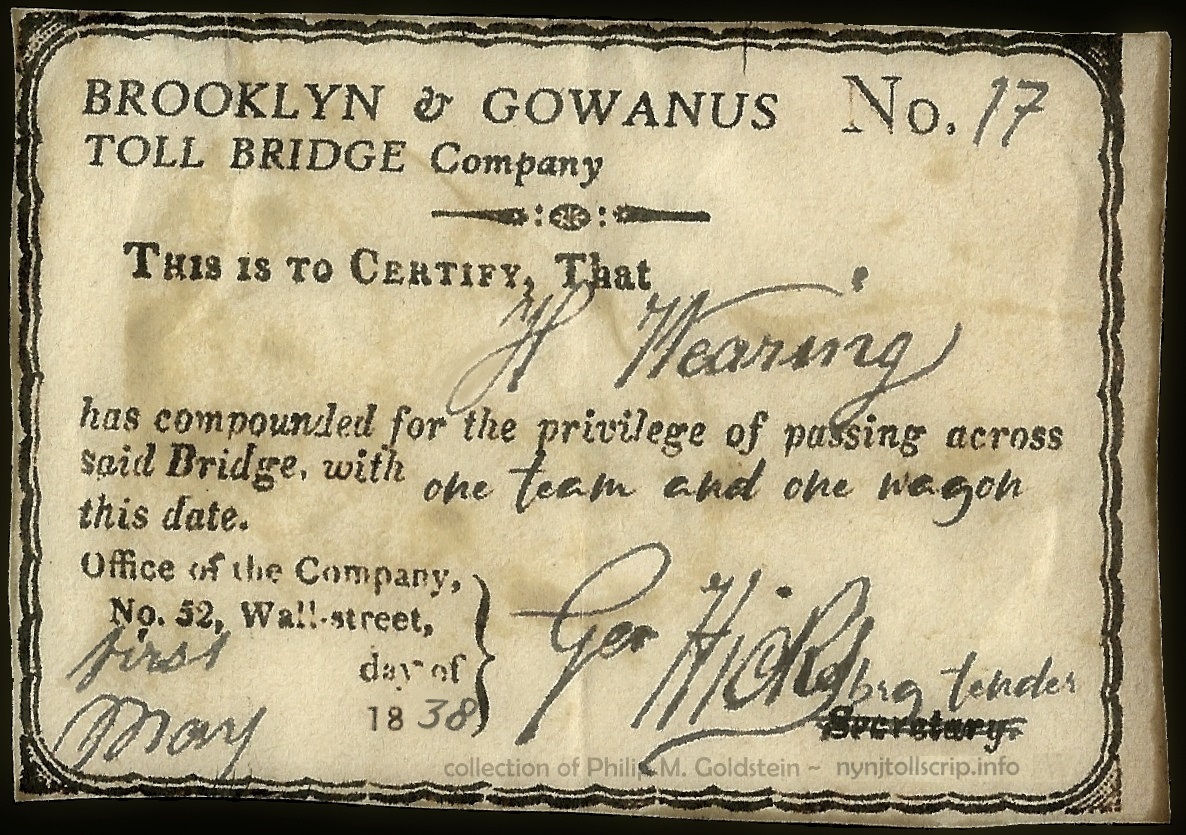 Brooklyn & Gowanus Toll Bridge Company - May 1, 1838 (near present day Hamilton Avenue Bridge, Brooklyn NY) collection of Philip M. Goldstein . My research has revealed the Brooklyn & Gowanus Toll Bridge Company was incorporated on April 29, 1833 and was dissolved in 1856. From what I have been able to ascertain, this was not without litigation as the dissolution was a result of the City of Brooklyn. As the City of Brooklyn set about improving the street grid in that area, they announced the construction of a new bridge to be built for Hamilton Avenue, albeit with no toll charged. This action by the City, took away the income Brooklyn & Gowanus Toll Bridge Company, as obviously those that traveled over the toll bridge would take the new adjacent free bridge and which in effect would put the Brooklyn & Gowanus Toll Bridge Company out of business. Obviously, this did not sit well with the principals of the Brooklyn & Gowanus Toll Bridge, and a lawsuit with at least one appeal was subsequently filed, with the matter dragging on to at least 1881. Ultimately, the City of Brooklyn was found liable and subsequently bought out the company and constructed the first of the Hamilton Avenue drawbridges over the Gowanus Canal; which to my understanding was replaced with a span in 1905. That span was replaced with the present pair of spans (one for each direction of traffic of Hamilton Avenue), which were constructed in 1942 and to which have subsequently been rebuilt in 2008 through 2009. A few of the names of the companies that were associated in collecting tolls were:
Now this next piece holds a very special place in my heart and I acquired it in February 2021. I grew up on Coney Island Avenue and Avenue S, from my birth in 1969 to 1998. On the four corners were as follows: (NW) Kinney Chevrolet open car lot for "OK Used Cars"; (NE) Manny's Luncheonette; (SE) private house and (SW) The Hobby House, where my father worked part time in the "Model Trains Department". As all of the commercial shops were on Coney Island Avenue, you could get anything from draperies, a glazer (glass cutter), headstones, pizza, re-upholstery, used or new cars, shoes repaired, TV's & radio's repaired and a whole lot more. All within walking distance from each other. My family used to walk from Avenue S to Avenue U about once a month (sometimes more) and eat at "Wong's" - a Cantonese Chinese Restaurant. My grandfather and the owner of Wong's, an old Chinese gentleman; would walk over to the OTB parlor around the corner together - Pop would come back, always paying for the meal with his winnings. Frankly, I think the Chinese guy had a fix in at the track and shared it with my grandfather, who was no slouch betting on the winning horses by himself. I remember when the old Mayfair Theater on corner of Avenue U and Coney Island Avenue was torn down and when the McDonald's was built in its place. Between Avenue T and Avenue U on the east side of the avenue was the Hot Bagel shop. Sunday mornings in my house meant fresh bagels, bialies and onion board, lox and cream cheese for the older folks. Grandma would put on hot tea and coffee and Uncle Joe and Aunt Ethel would drop by. I would get a Sun-Dew drink (orange or fruit punch) in a little square container with a little bendy straw (primitive to drink boxes to today). The Sunday Daily News was as thick as my arm, and came wrapped with multiple pages of vividly colored Sunday Comics. One evening, my father and I watched when the NYC DOT milled down and resurfaced Coney Island Avenue in the 1970's, revealing the old street car tracks underneath the asphalt! Later in life, Coney Island Avenue became the primary route for me to go to either my Junior High School in Sheepshead Bay; which required a ride on the B68 (Coney Island Avenue) to the B4 (Neptune Avenue / Emmons Avenue); or to High School: the B68 to Avenue M and change for the B9 to Midwood. So, Coney Island Avenue was my "main street" to growing up.
Very few photos exist from this era, much less something as mundane as roads. There is one photograph that makes it regular circulation through internet groups pertaining to Brooklyn history, and that is of the Flatbush Toll Booth of the Brooklyn Jamaica & Flatbush Turnpike Company. It resides in the collection of the Brooklyn Public Library: 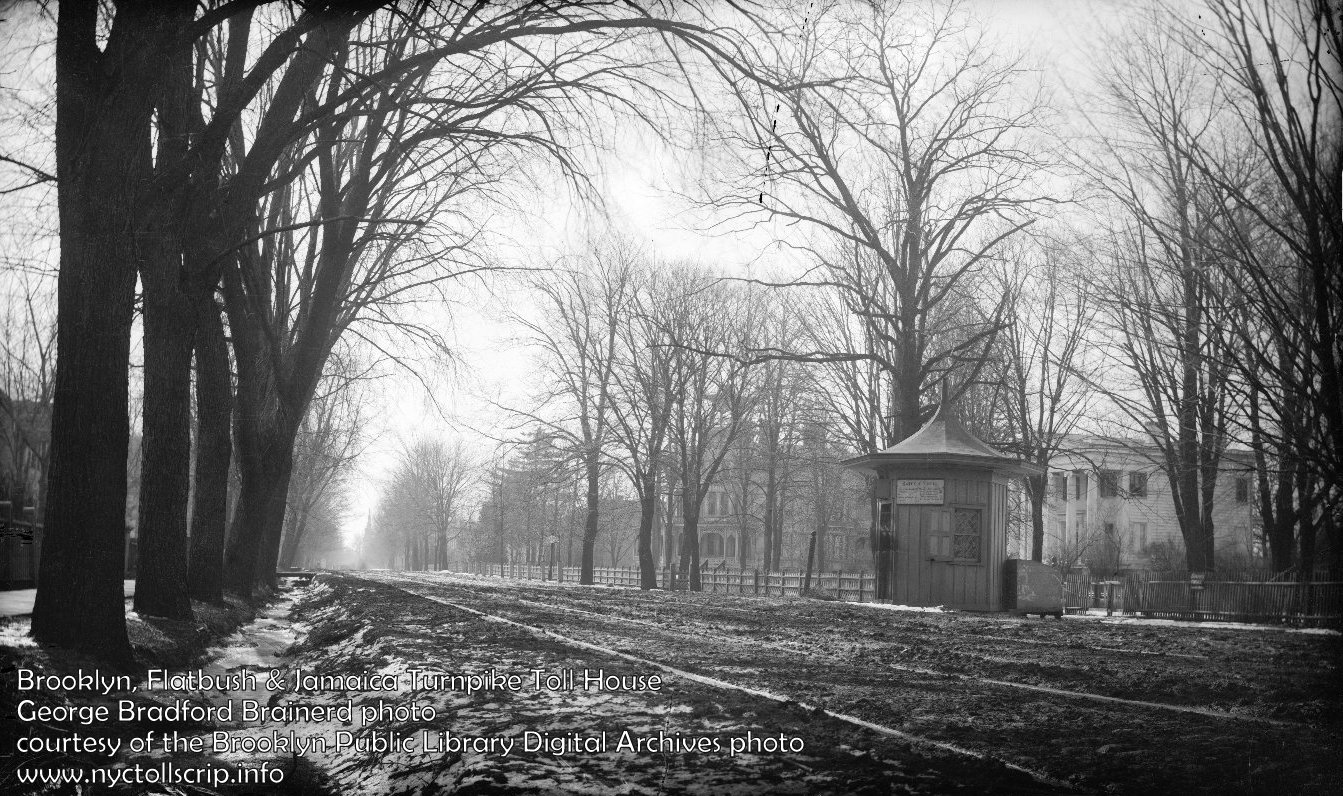 . Ironically, one of those tollbooths survives to this very day and is located in Prospect Park, Brooklyn. Several webpages and blogs pertaining to the history of Brooklyn covered its history and its saving for posterity, so just look it up on the web. While images maybe scarce, basic information is a little more forthcoming. Fortunately, Google Books is readily available for reference and I located this publication; of which I have reproduced the pertinent pages here: 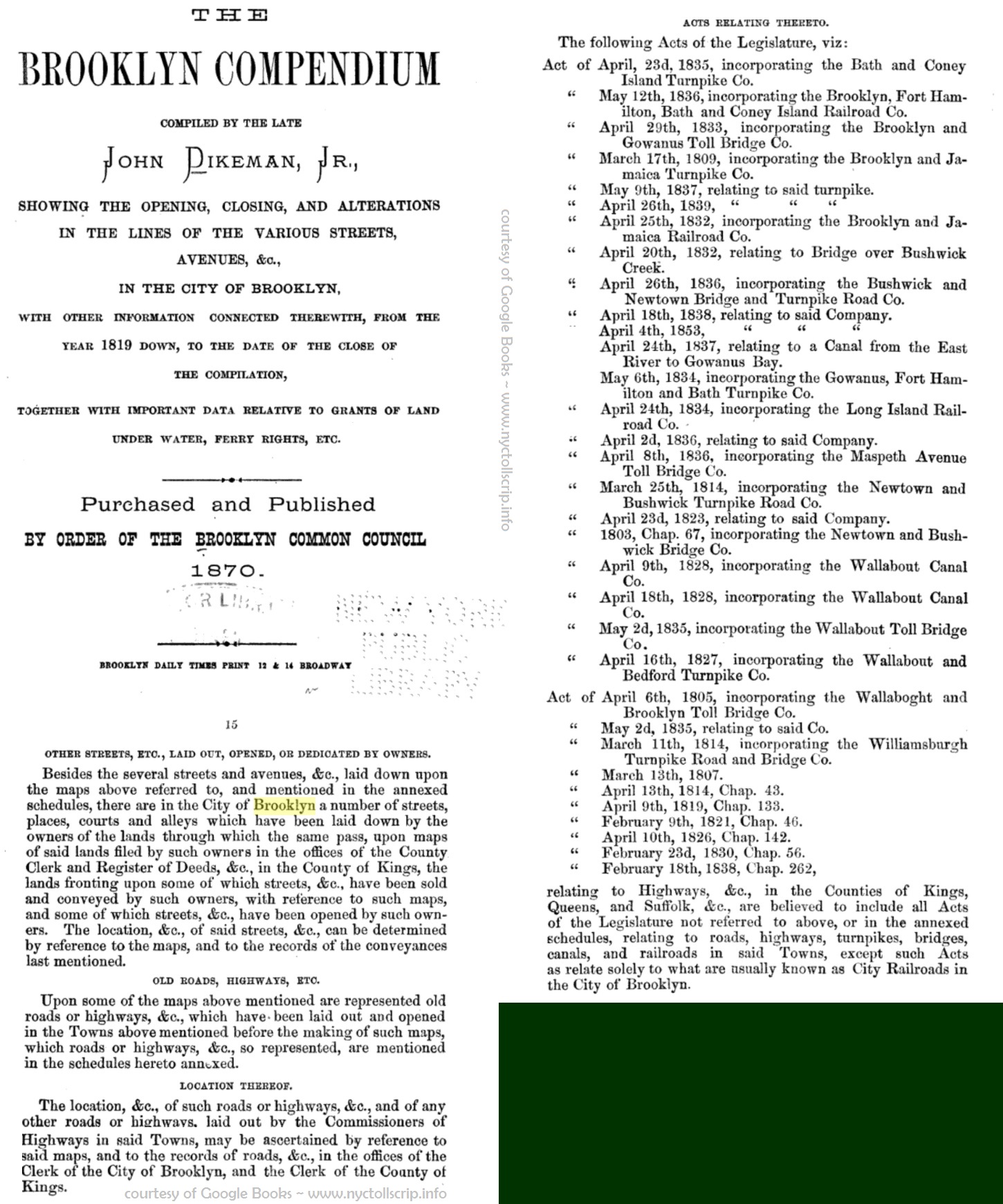 "The Brooklyn Compendium" John Dykeman, Jr - 1870 courtesy of Google Books added 13 February 2021 . 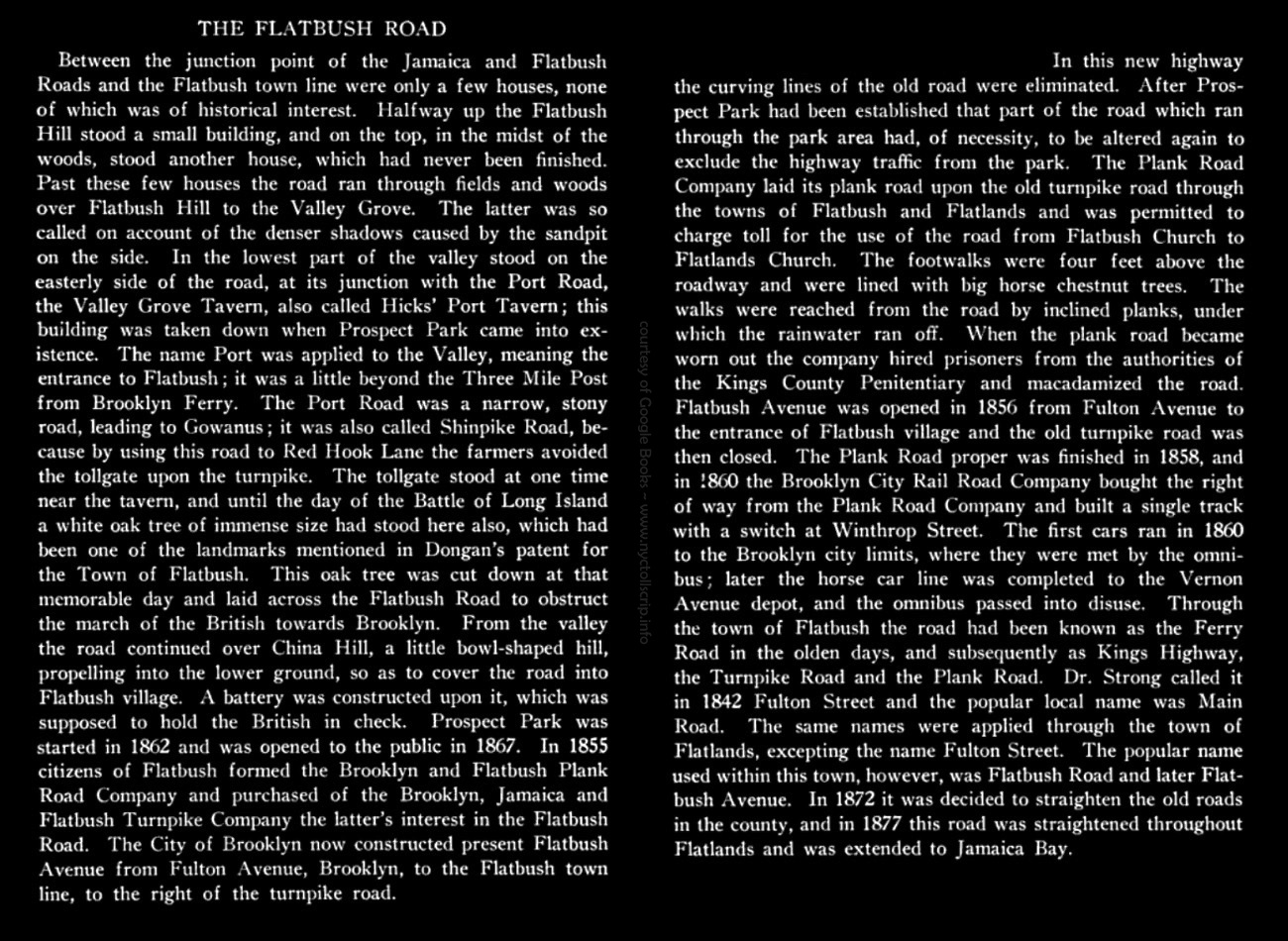 "The Ferry Road on Long Island" Eugene L. Armbruster - 1919 courtesy of Google Books added 13 February 2021 As I do further research for this page, certain recollections are triggered. After finding the above Armbruster entry; I remembered that I had a well aged copy of Eugene L. Armbruster's "Brooklyn's Eastern District" - 1942; and even so, I knew the compilation of history dated back to the early 1800's. So, I commenced in scanning the appropriate paragraphs and compiling them here: 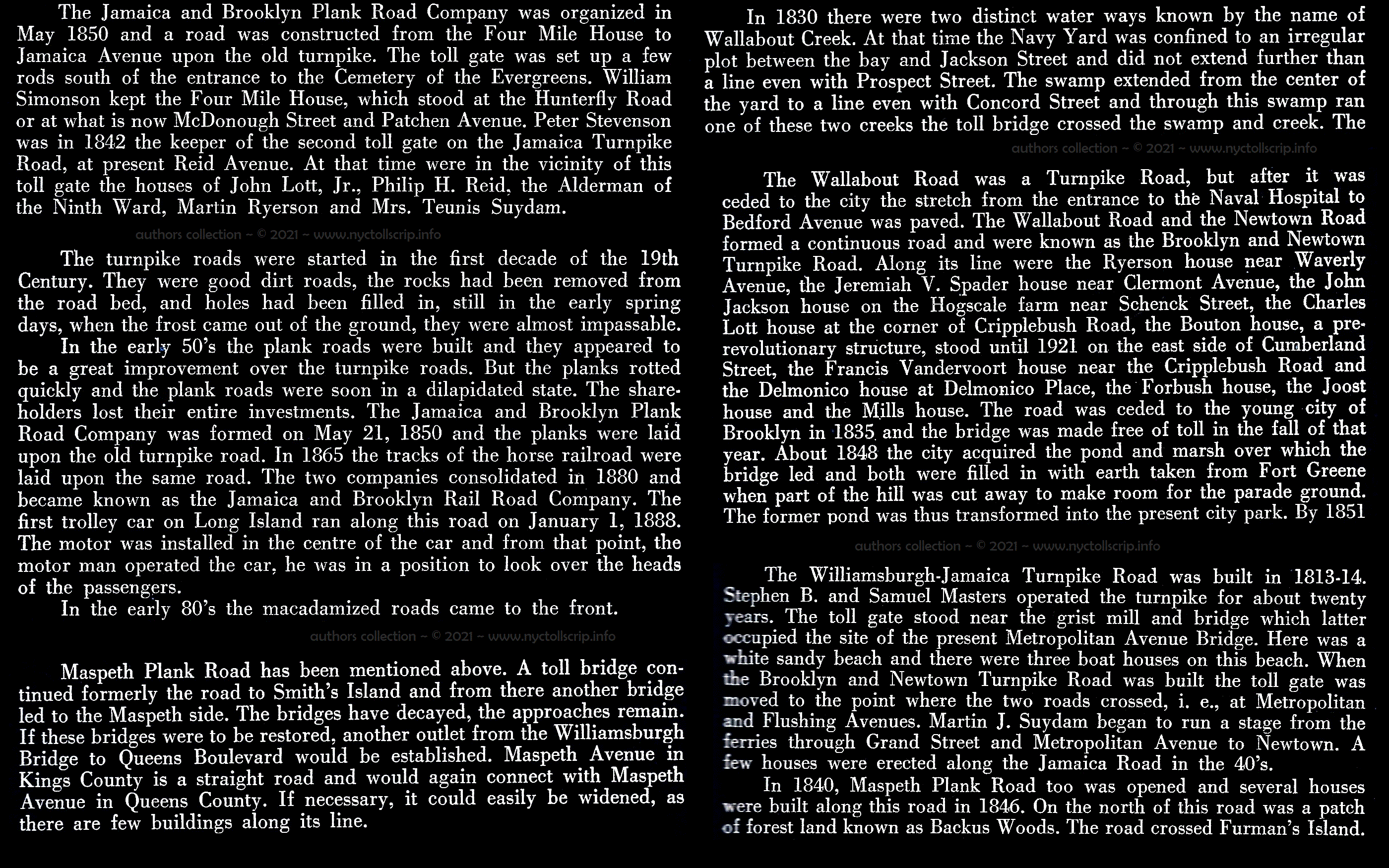 "Brooklyn's Eastern District" Eugene L. Armbruster - 1942 collection of Philip M. Goldstein added 13 February 2021 . 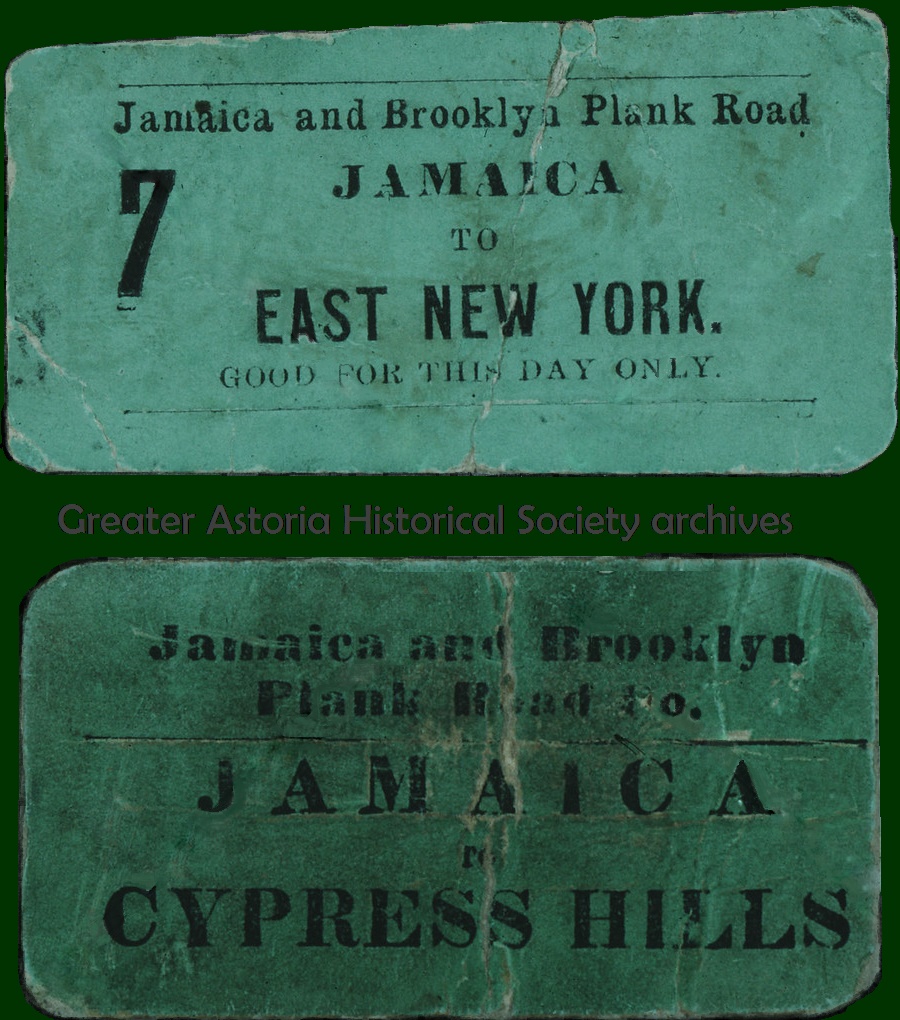 Jamaica and Brooklyn Plank Road Co. Tickets courtesy of the Greater Astoria Historical Society added 13 February 2021 . And keep in mind, these compilations pertained almost exclusively for the City of Brooklyn. We can be certain the Bronx and Queens had their own private roads and crossings as well. City
of New York - Department of Bridges As
I am sure a lot of the casual readers may not be aware (especially
those not from the New York City area); that the East River Bridges
collected tolls as well, when they were first opened. These crossings include the:
These bridges have become to be known by the New York City driver as "free" bridges in the present day conversation, when held in discussion with the tolled crossings of the Triborough Bridge and Tunnel Authority and Port Authority of New York and New Jersey. But in fact, tolls were collected on these East River spans when they first opened individually (1883 through 1909 respectively) and these tolls were collected until 1911, when it was realized the City of New York was not legally empowered to collect tolls, and thereby the tolls were abolished. This is just another little tidbit of history that has been lost to time. That is, until now. As I research deeper into the existence of toll collection on the City of New York bridges; I encounter thousands of images but so few of the toll booths. So far, I have only been able to locate two photos; both of which attributed to George Hall. Both taken at almost the same location (the curve on the Brooklyn side) however they clearly have been taken on two different dates as the elevated trains and trolley wire support structure is different. 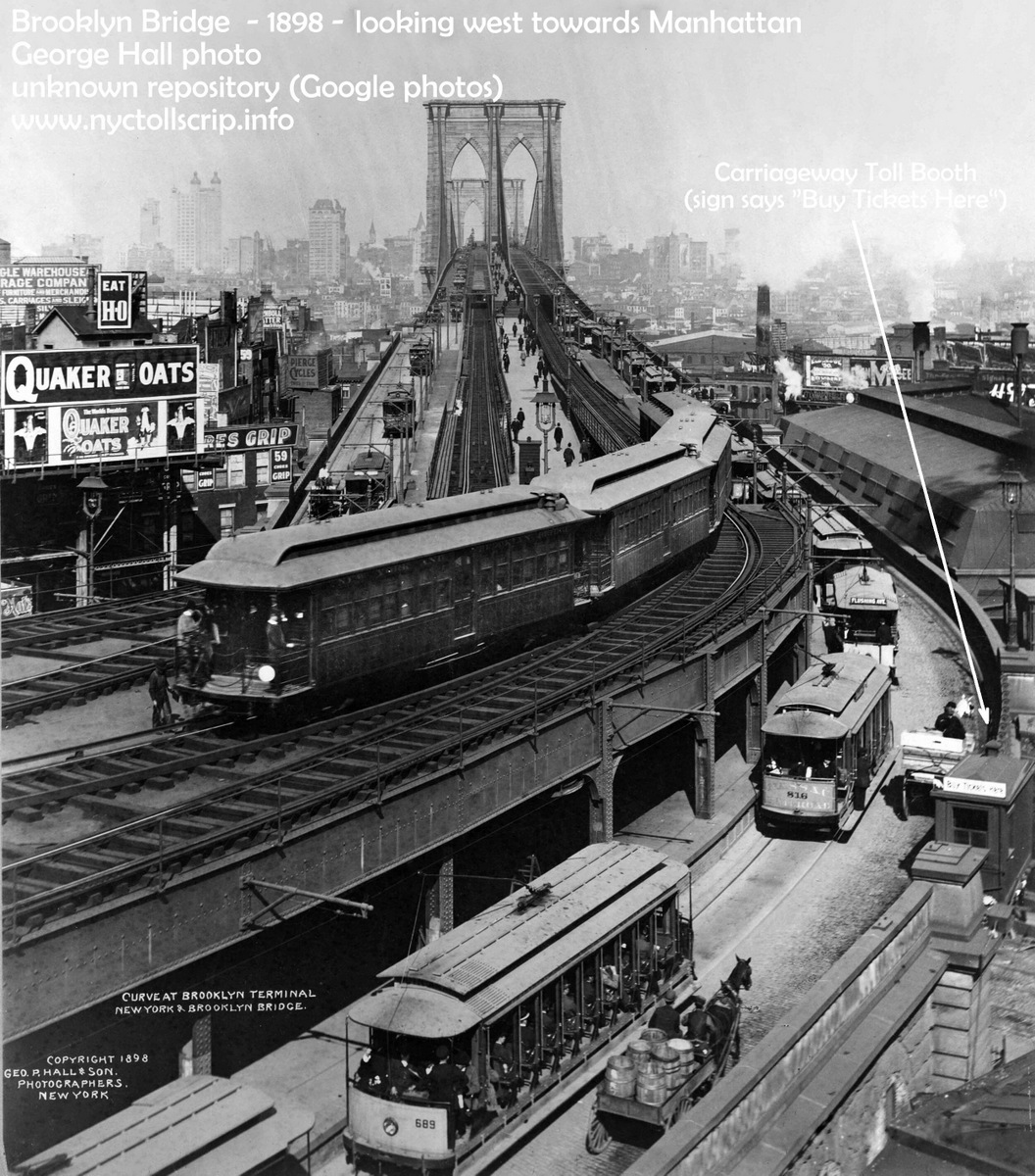 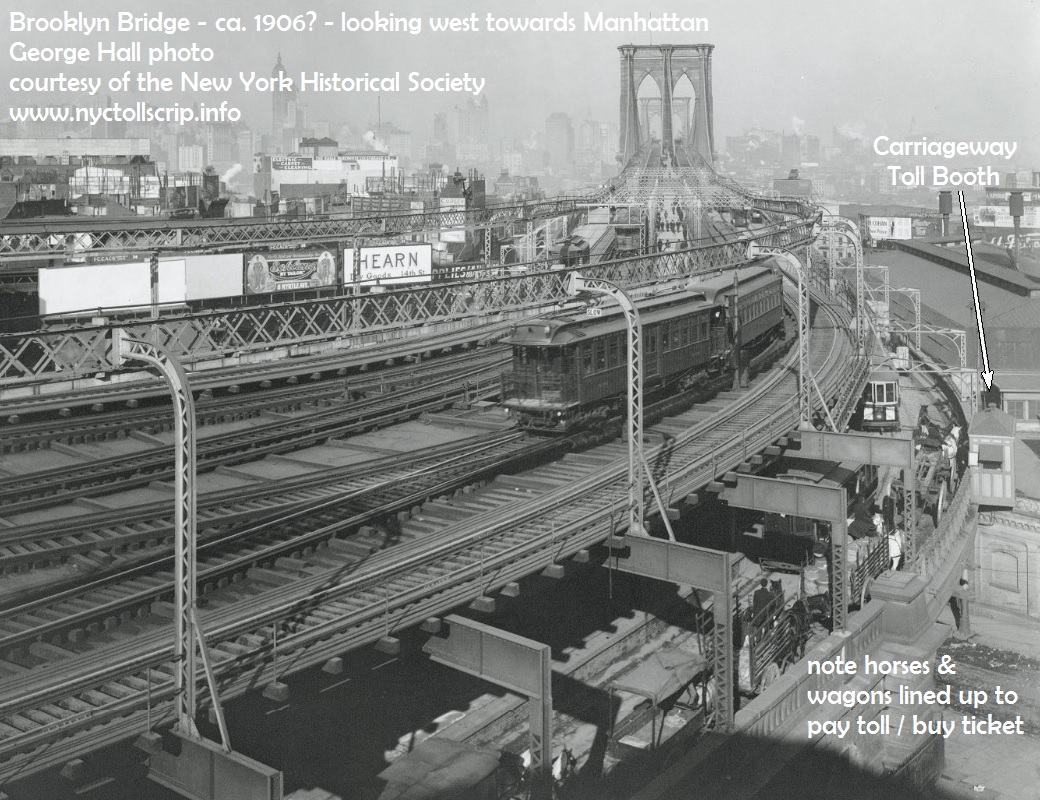 Moving onto the known ticket issues marked for the Brooklyn Bridge, we know of three distinct design types. The Promenade ticket is prolific, but often listed as a subway or train ticket on eBay. As a result of this erroneous belief of being a railroad or subway issue, it is one of the most misunderstood and misattributed ticket issues circulating in the category of historical ephemera for New York City, and I sincerely hope this website can correct this. First and foremost, when comparing New York & Brooklyn Bridge Railroad tickets to the other issues, the others are very conspicuously marked "Promenade" or "One Horse Vehicle" and these issues clearly lack the word "railroad":
In further discussion of the blue One Horse Vehicle Specimen Tickets; it is the estimation of George Cuhaj that several specimen sheets were sold when the archives and records of the American Bank Note Company were liquidated and auctioned off during sales were which were both held privately and in public auction sales held by Christie's NY during the late 1980s and early 1990s. Many of the groups of items sold in large lots, and have yet to fully come onto the market. Presumably, one or several of the sheets were subsequently cut up, so individual tickets could be sold. This is further evidenced by the registration mark on the left edge margin of the ticket that sold on eBay, as the uncut sheet shown has an identical registration mark on the left margin as center. Some interesting differences are seen between the cut tickets above center and below left and the uncut sheet seen below right. The first is the uncut sheet has punch cancellation holes through each ticket. The second difference observed, is the uncut sheet of tickets seen below right, has the overprinted word "SPECIMEN" in a sans-serif font, while the individual tickets above center and below left have the word "SPECIMEN" in a serif font and at different angle to the uncut sheet. Interesting to say the least. At the very least, the stamp date of June 1901 on the uncut sheet helps date the issue. George has also noted; that to date, no examples of this ticket have ever been seen in circulated condition and / or lacking the specimen overprint. The only questions that remain now, are: a) were the tickets produced and issued; and b) were there any other denominations, i.e.: two horse vehicle or other denominations for the toll?
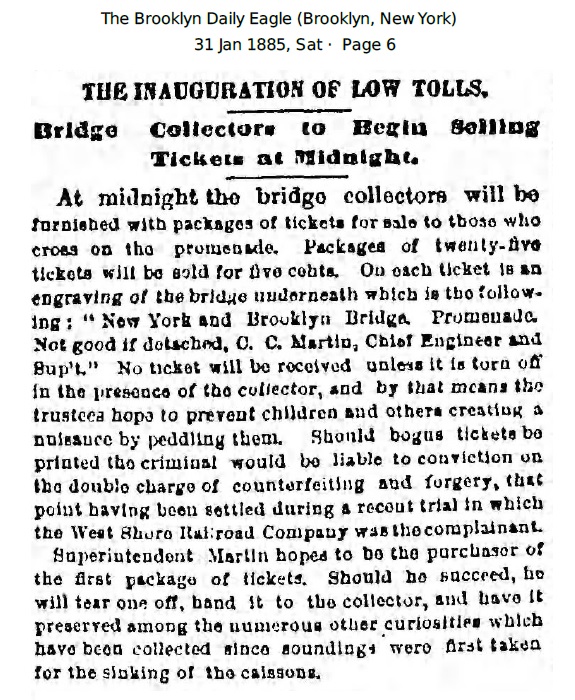
Also located is this article published by the New York Times on December 28, 1895; which covered the railway and carriageway issues of the Brooklyn Bridge tickets:
Upon finding a copy of the "Minutes of the Board of Estimate and Appointment of the City of New York" it is then learned that all the tolls were abolished on all other East River Bridges by August 31, 1911. So, what are the ticket worth? Other than essays, proofs, specimens & samples, the issued New York & Brooklyn Bridge Promenade and the New York and Brooklyn Bridge Railroad tickets are common; with no less than half a dozen listed for sale on eBay in Buy It Now or auction formats, in various conditions; at any given time. Furthermore, if you are patient, you will even see them listed in strips of four, five or more tickets still attached. Are they worth $45 each? Not on your life. If you think they are, then I've got both a bridge in Brooklyn and swampland in Florida to sell you. And maybe I'll just list it on eBay as "RARE! Waterfront Property." In short, the Brooklyn Bridge Promenade Tickets were not railroad. Not cable car, not trolley car, not elevated railway, not subway or anything else associated with any railroad. They are pure and simply: pedestrian toll tickets. Are they a unique piece of history? Absolutely. Do they carry an aura of nostalgic times of yesteryear? Yes. Are they rare? No. Strictly as a convenience to the reader, I include information from the Wikipedia page on the Brooklyn Bridge about the New York and Brooklyn Bridge Railroad for those collecting those ticket issues:
Literally within minutes of going public with this page, George S. Cuhaj, (an established token collector and author) sends me the following image, asking if I would be willing to include the East River Bridge issues on the page? Sure, why not! After all, they are bridge tickets from New York City, right? The following is a fare ticket for a led horse on the carriageway of the Manhattan Bridge. I believe the cost was 3 cents, and it is facsimile signed by J. W. Stevenson, Commissioner of Bridges for the City of New York. The Manhattan Bridge opened on December 31, 1909. This piece is interesting to say the least, and according to the Proceedings of the American Society of Civil Engineers, Volume 45, 1919; horse-drawn traffic on the Manhattan Bridge was prohibited during certain times of the day: "The
Manhattan Bridge roadway is 35 feet wide, sufficient to pass two lanes
of traffic in each direction. In order to care for the morning and
evening rush-hour traffic on this bridge, horse-drawn vehicles are
prohibited from crossing from Brooklyn in the evening period and from
Manhattan in the morning period. During both these periods this traffic
is diverted to the Brooklyn Bridge, making it possible to accommodate
three lines on the Manhattan Bridge from Brooklyn in the morning rush
and to Brooklyn in the evening rush."
Further research has uncovered that the four East River Crossings
(from south to north): Brooklyn Bridge, Manhattan Bridge, Williamsburg
Bridge and the Queensboro Bridges collected tolls for use of the
roadway. To be absolutely clear, these were NOT a collection of fares
for the streetcars or trolley lines crossing those bridges; this was for
automobiles, horses & horse & wagons utilizing the roadway. It
is further understood the toll was 3 cents for horses, 5 cents for horse and wagons and 10 cents for automobiles.Take note of the artwork at the top of the Brooklyn Bridge Promenade ticket above; and compare to the artwork of this Manhattan Bridge ticket. it is the same silhouette of the tower with Gothic arches with cables! In reality, the Manhattan Bridge has a single Roman arch. Apparently, the same artwork was used, or at least copied; from the Brooklyn Bridge issue.
Williamsburg
Bridge
Further research on the subject has revealed that the Williamsburg
Bridge also collected tolls for automobile and horse drawn traffic
crossing the span. Again, this was not a fare collected for streetcar
or trolley car lines crossing the bridge.
It is understood the toll was the same as the Manhattan Bridge and fixed at 3 cents for horses, 5 cents for horse and wagons, and 10 cents for automobiles. At this time, tickets or scrip have not been seen. But I have encountered at least two images that shows the toll booths. One is dated April 1906; three years after the bridge opened. The other is undated. What is interesting is it appears there were two different styles of toll booths. And ornate style on the Manhattan side, and a simpler structure on the Brooklyn side. This may have been a policeman's shanty, but I am uncertain. Considering the tolls were abolished from the City owned bridges in 1911; there is only a small window of time in which the toll booths may be seen in photographs. 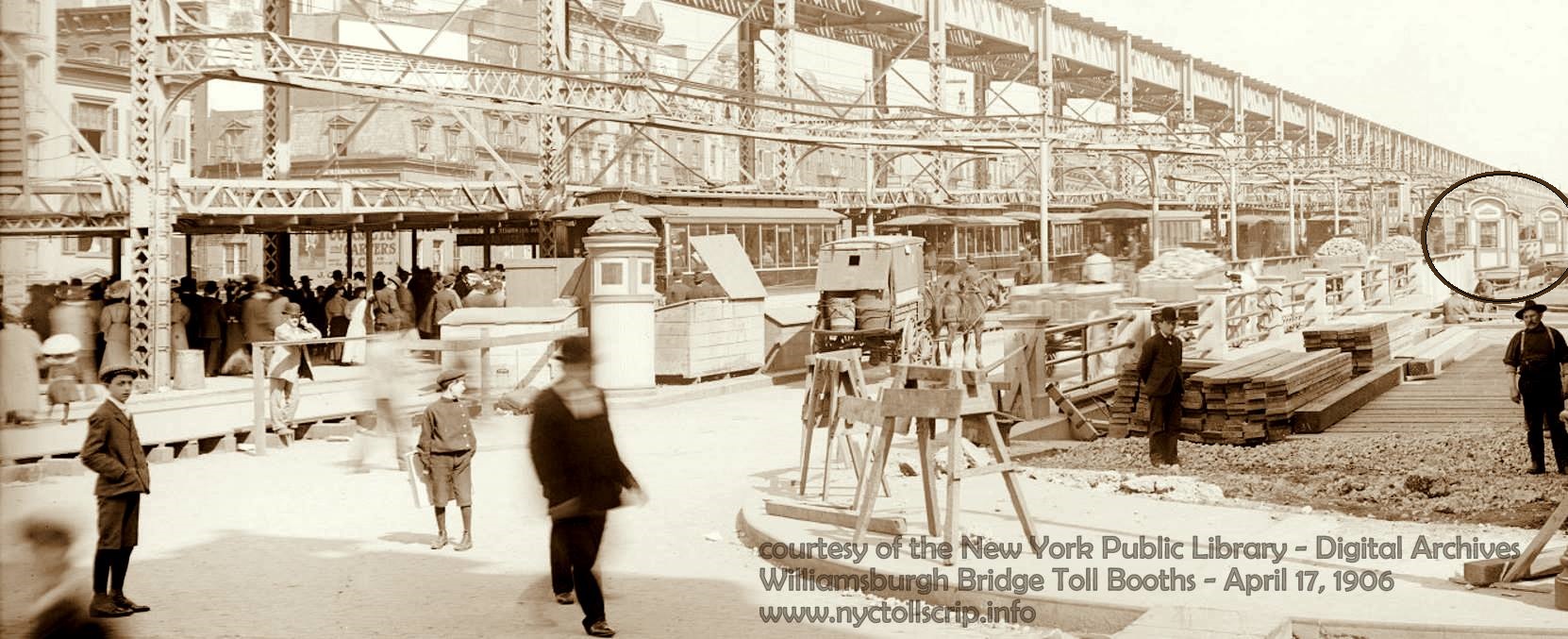 courtesy of the New York Public Library Digital Archives added 13 February 2021 . 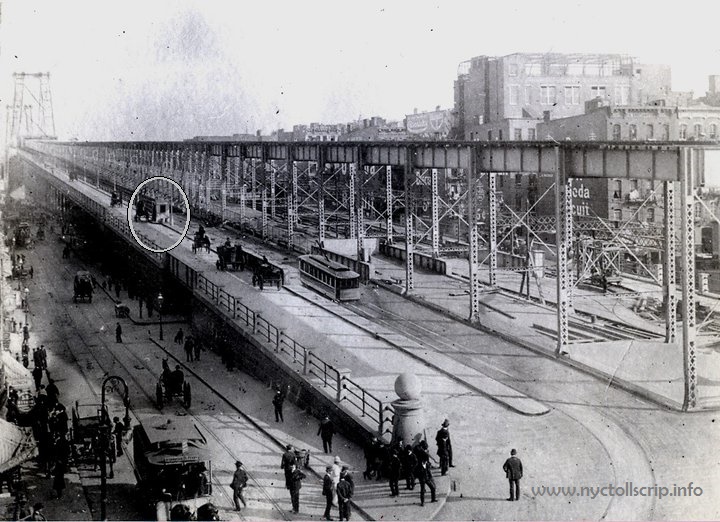 I cannot remember the provenance of this image. If you know, please feel free to contact me. added 13 February 2021 . Blackwells
Island / 59th Street / Queensboro Bridge
From
the same documents that revealed the collection of tolls for the
Williamsburg Bridge, it was also learned the Blackwell's Island Bridge
collected a toll as well. This bridge is better known today as the
Queensboro - 59th Street Bridge.
And once again, to be absolutely clear, this was a toll for automobiles and horse drawn vehicles. Toll rates were 3 cents for horse, 5 cents for horse and wagon, 10 cents for automobiles. The following image is in the archives of the Greater Astoria Historical Society, and is simply dated 1909. It is unclear at this time if the image was taken for the grand opening of the Queensboro Bridge, which took place on March 30, 1909; or was taken on the occasion of a Motor Parade and Auto Celebration during the week of June 12th through the 17th of that year, and on which date the toll was waived for all "machines" that compete in Long Island. Judging from the heavy coats being worn by the men in the image - I believe this to be on the the date of grand opening.  Queensboro Bridge Toll Booth - 1909 (Believed to be Grand Opening of Bridge) Lead automobile is the Commissioner of the City of New York Department of Bridges. Notice automobile has right hand drive. courtesy of the Greater Astoria Historical Society added 13 February 2021 We also now know, by way of the following New York Times article dated July 7, 1911; why toll collection on the East River Bridges ceased. 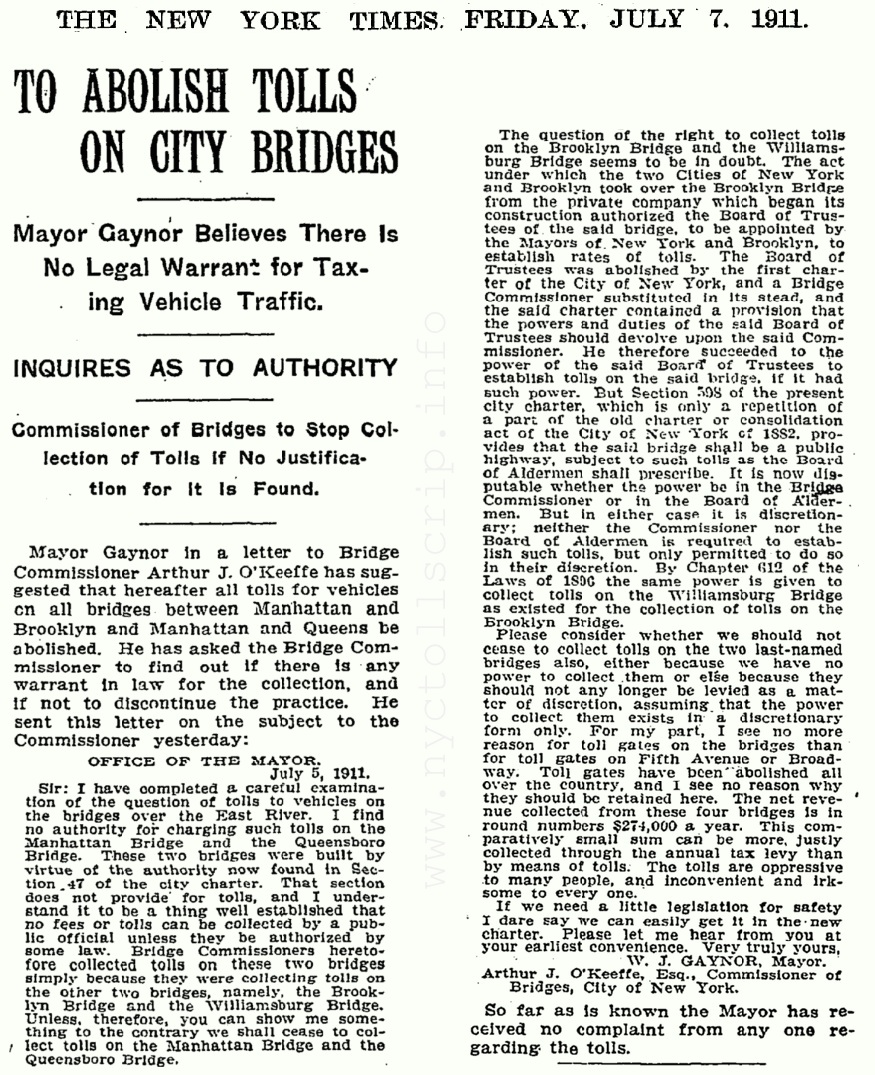 | |||||||||||||||||||||||||||||||||||||||||